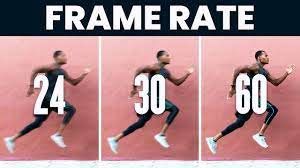In the realm of digital entertainment, there’s a hidden force at work, silently shaping our visual experiences. It’s called frame rate, and it’s the secret sauce that makes videos and games appear smooth and lifelike. But what exactly is frame rate, and why is it so important?
Frame Rate: The Unsung Hero of Visuals
Imagine a flipbook, a collection of still images that, when flipped rapidly, create the illusion of motion. That’s essentially how videos work. Each individual image is called a frame, and the number of frames displayed per second is the frame rate. The higher the frame rate, the smoother and more fluid the motion will appear.
In the world of video, 24 frames per second (fps) is considered the standard for cinematic experiences, mimicking the natural movement of film. However, for fast-paced action scenes or video games, a higher frame rate is often preferred to ensure a crisp and responsive experience.
The Impact of Frame Rate on Different Scenarios
Frame rate plays a crucial role in various aspects of digital media. Let’s explore how it impacts different scenarios:
Movies: Hollywood blockbusters typically adhere to the 24fps standard, creating a cinematic feel that immerses viewers in the story. The slower frame rate adds a touch of realism, reminiscent of the classic film era.
TV Shows: Television broadcasts generally follow the 30fps standard, providing a balance between smoothness and visual quality. This frame rate is considered sufficient for most TV programming, from sitcoms to dramas.
Video Games: For gamers, frame rate is paramount, especially in fast-paced action titles. A higher frame rate, such as 60fps or even 120fps, ensures smoother gameplay, quicker reflexes, and a more competitive edge.
Frames Per Second Test: Unveiling Your Device’s Performance
Curious about your device’s frame rate capabilities? Online frame rate test can help you determine the maximum frame rate your device can handle. These tests typically involve playing a simple animation or game and measuring the frame rate throughout.
Optimizing Frame Rate for Optimal Experiences
To maximize your visual experience, consider these frame rate optimization tips:
For movies and TV shows: Stick to the default frame rate settings unless your device supports higher frame rates.
For video games: Adjust the in-game graphics settings to prioritize frame rate over visual quality if you prefer smooth gameplay.
For video editing: If you’re creating videos, consider using a frame rate that matches the source material or the intended platform.
The Future of Frame Rate: Reaching New Heights
With the advancements in technology, frame rates are constantly pushing the boundaries. High-end gaming monitors and TV are now capable of displaying 240fps or even 360fps, providing an incredibly immersive and responsive visual experience.
Conclusion
Frame rate is an often overlooked yet crucial aspect of digital entertainment. By understanding its impact and optimizing settings accordingly, you can elevate your viewing and gaming experiences to new heights of smoothness and responsiveness. So, the next time you watch a movie, play a game, or create a video, take a moment to appreciate the invisible force that’s making it all happen – the power of frame rate.




